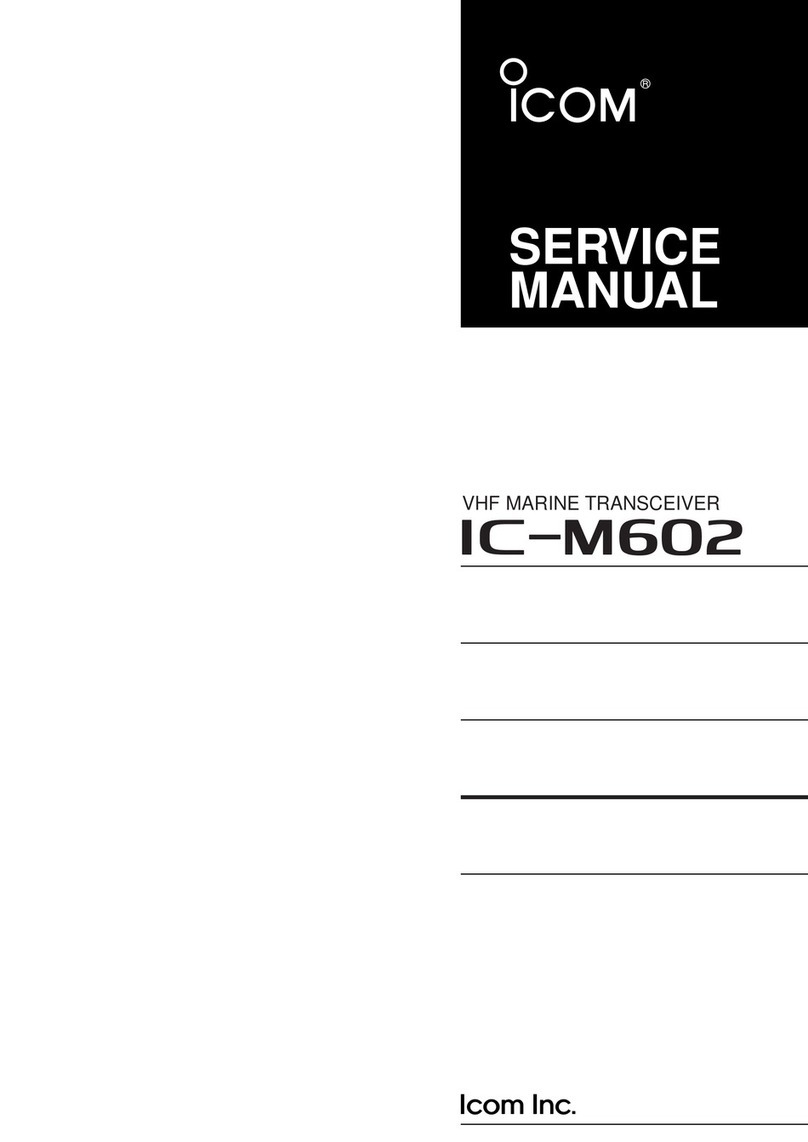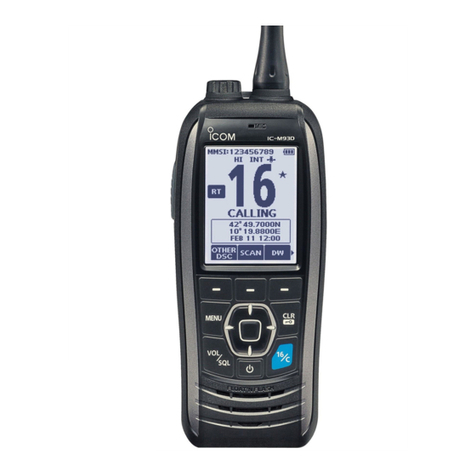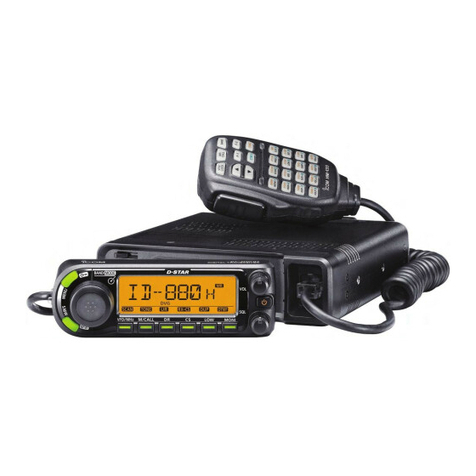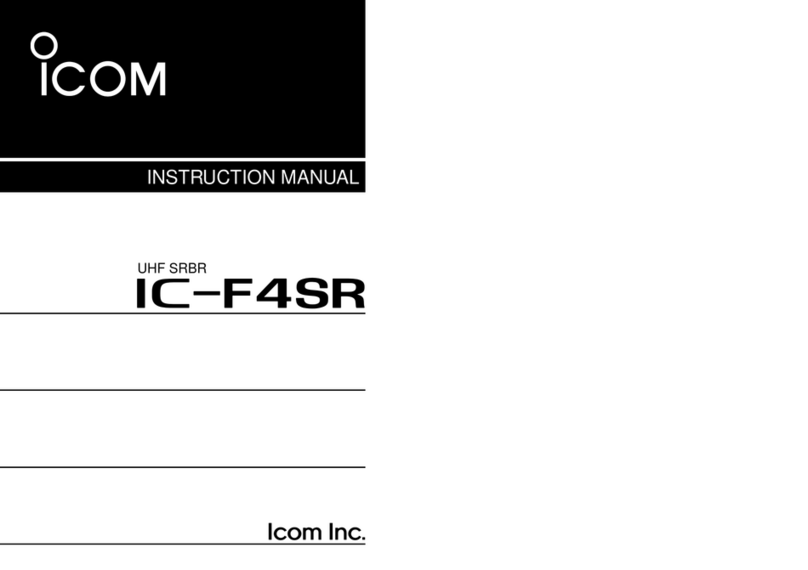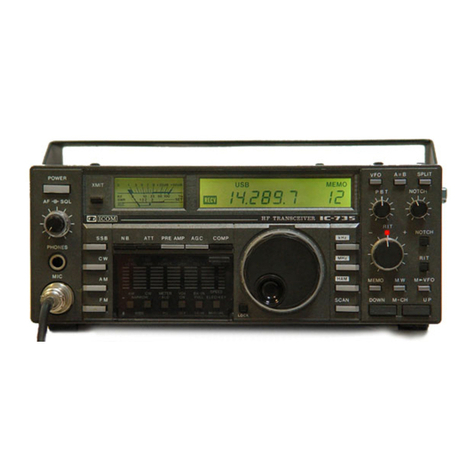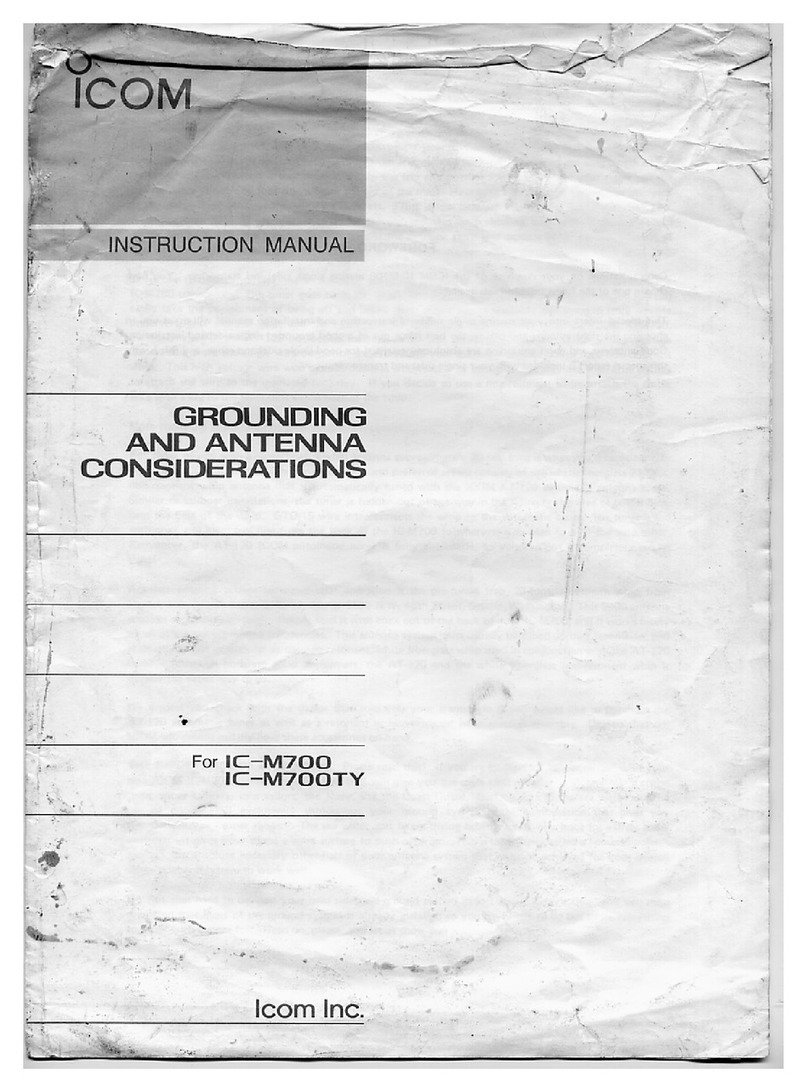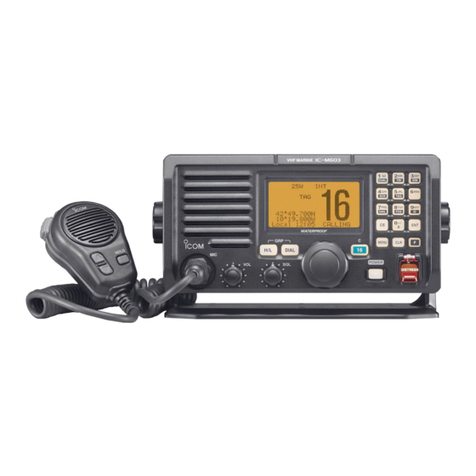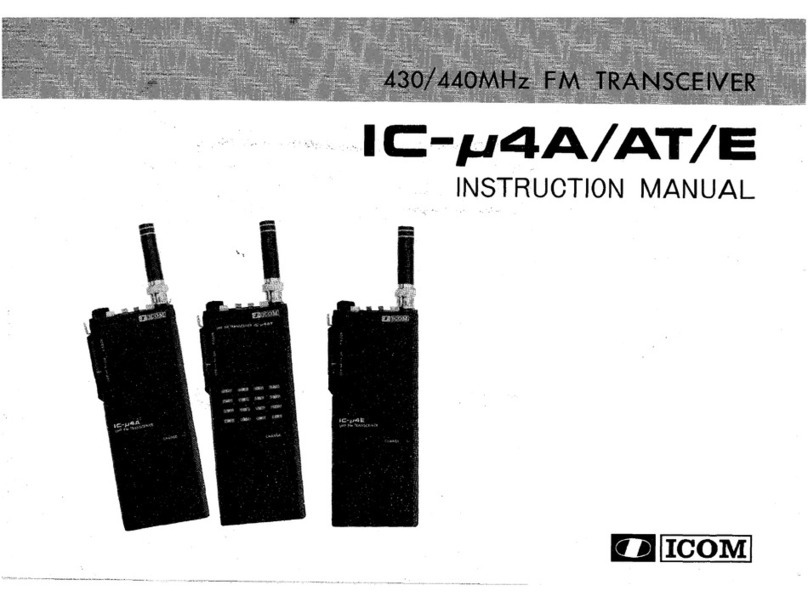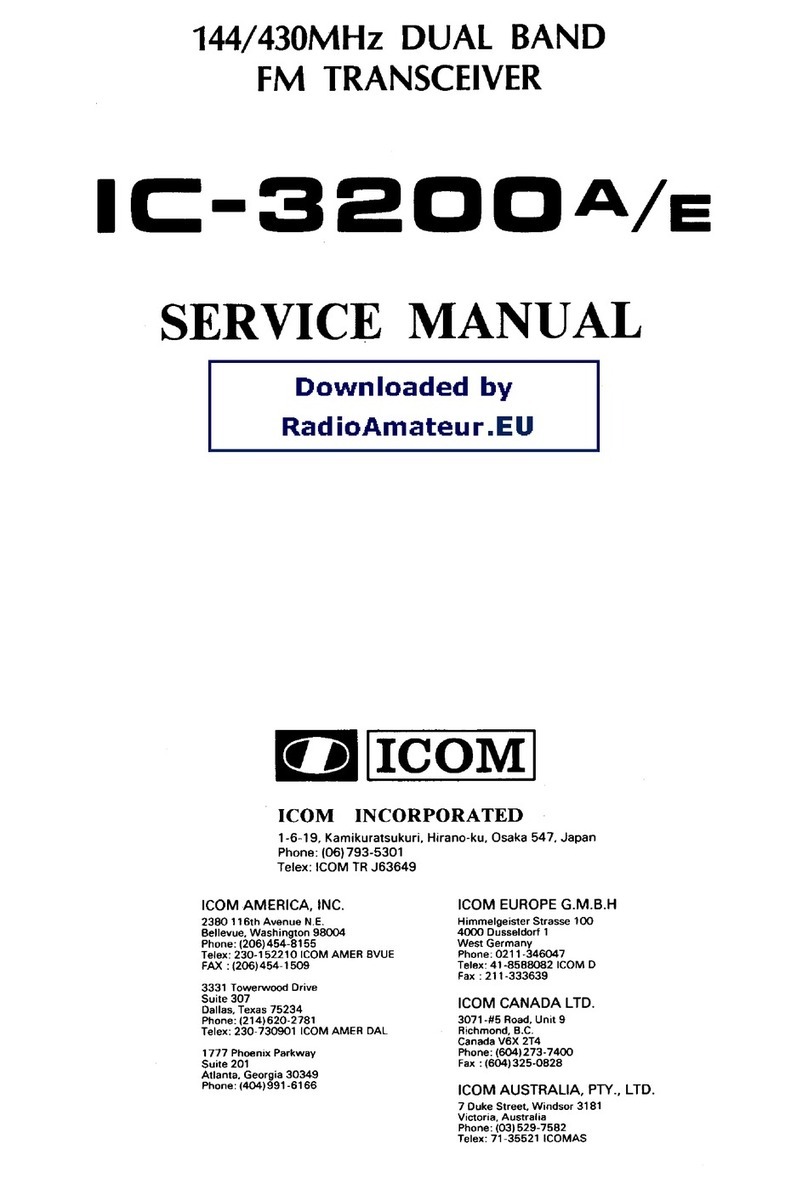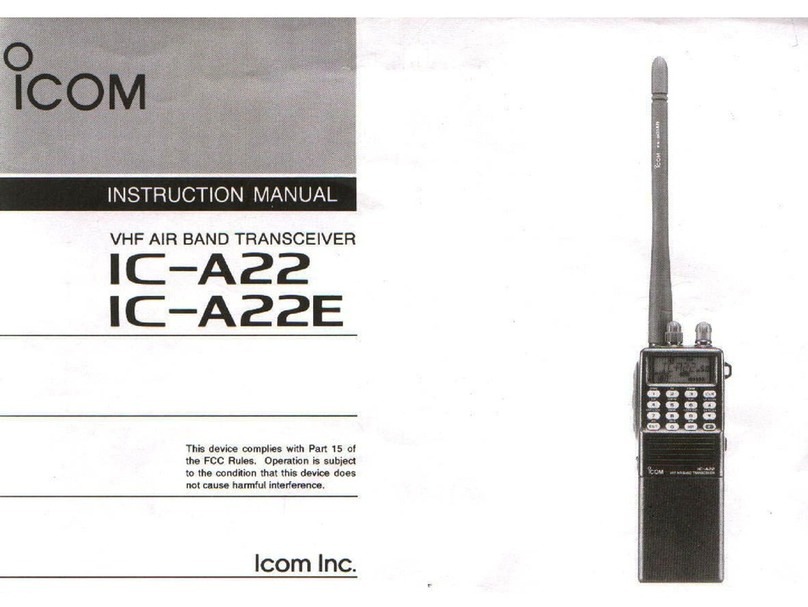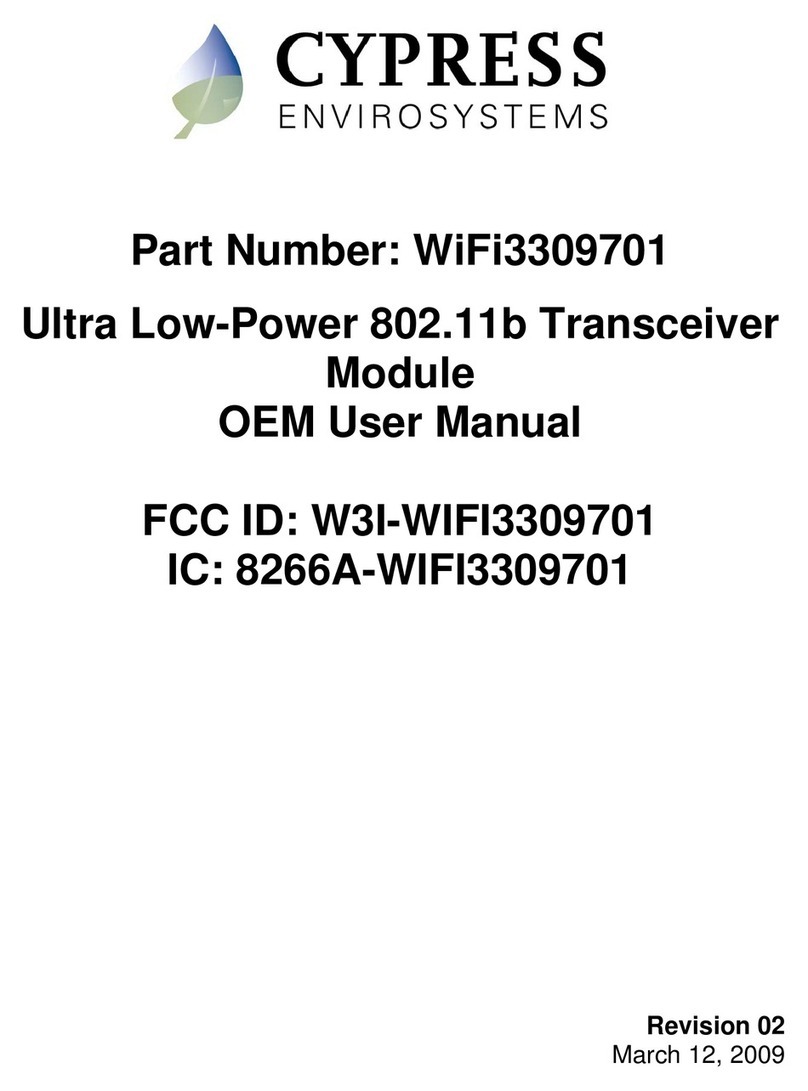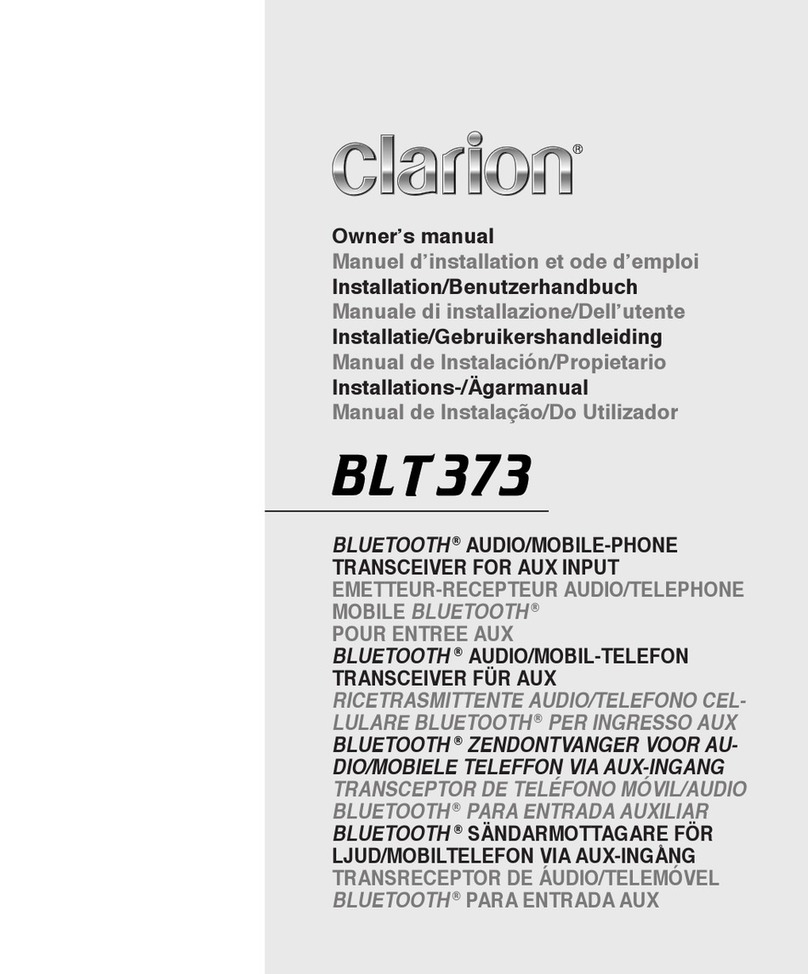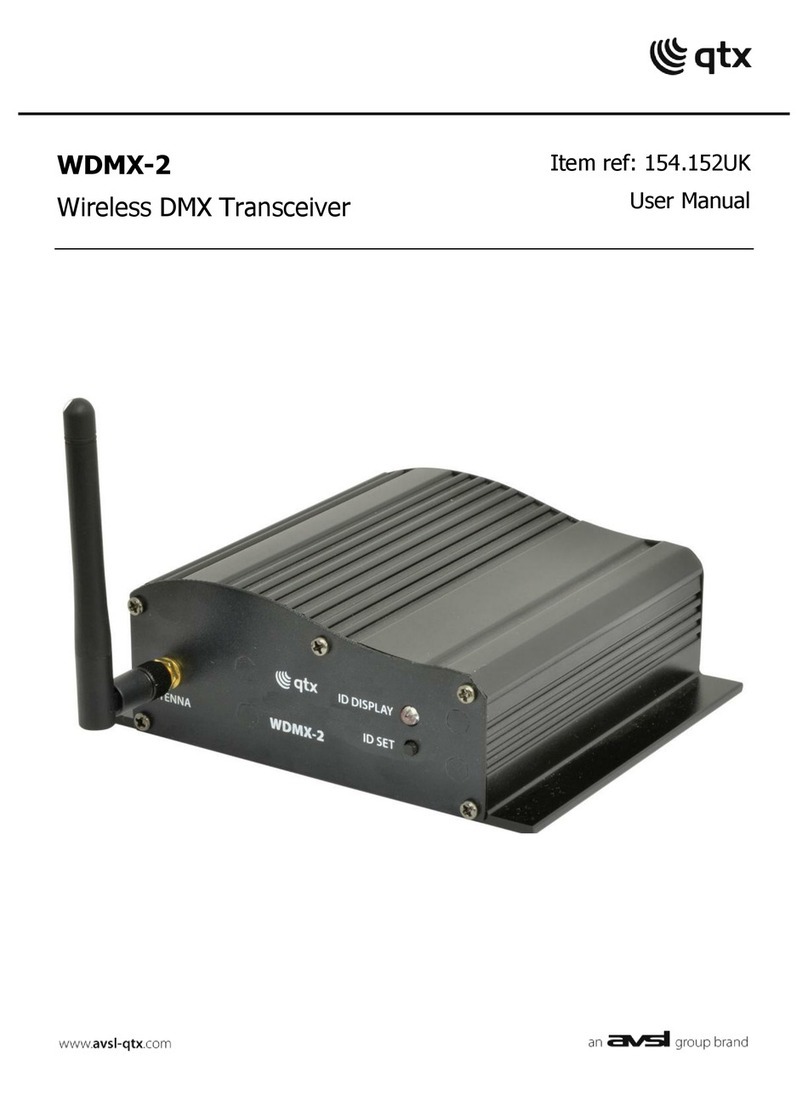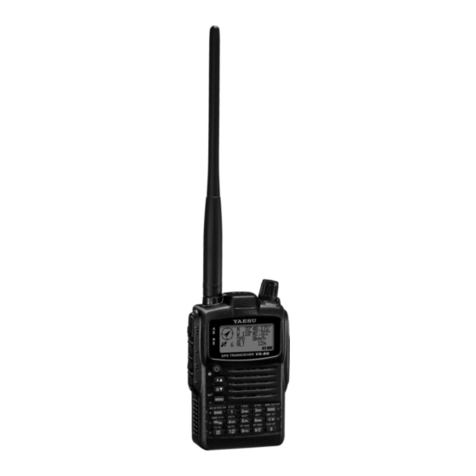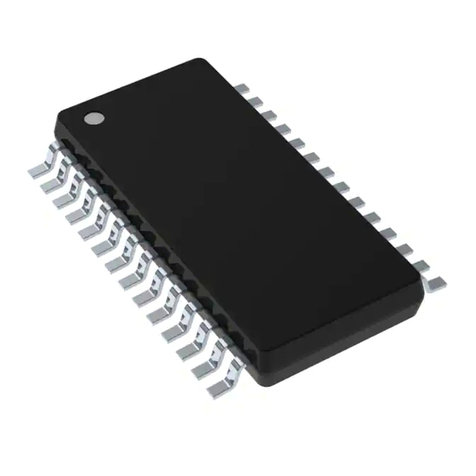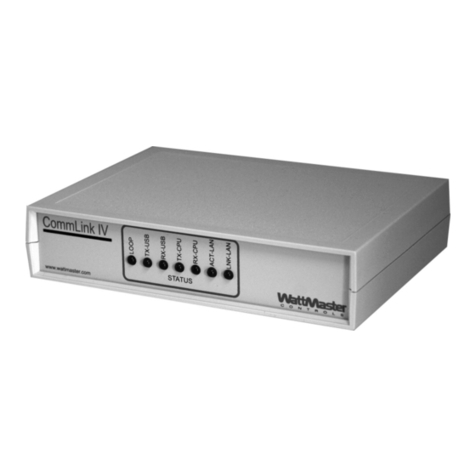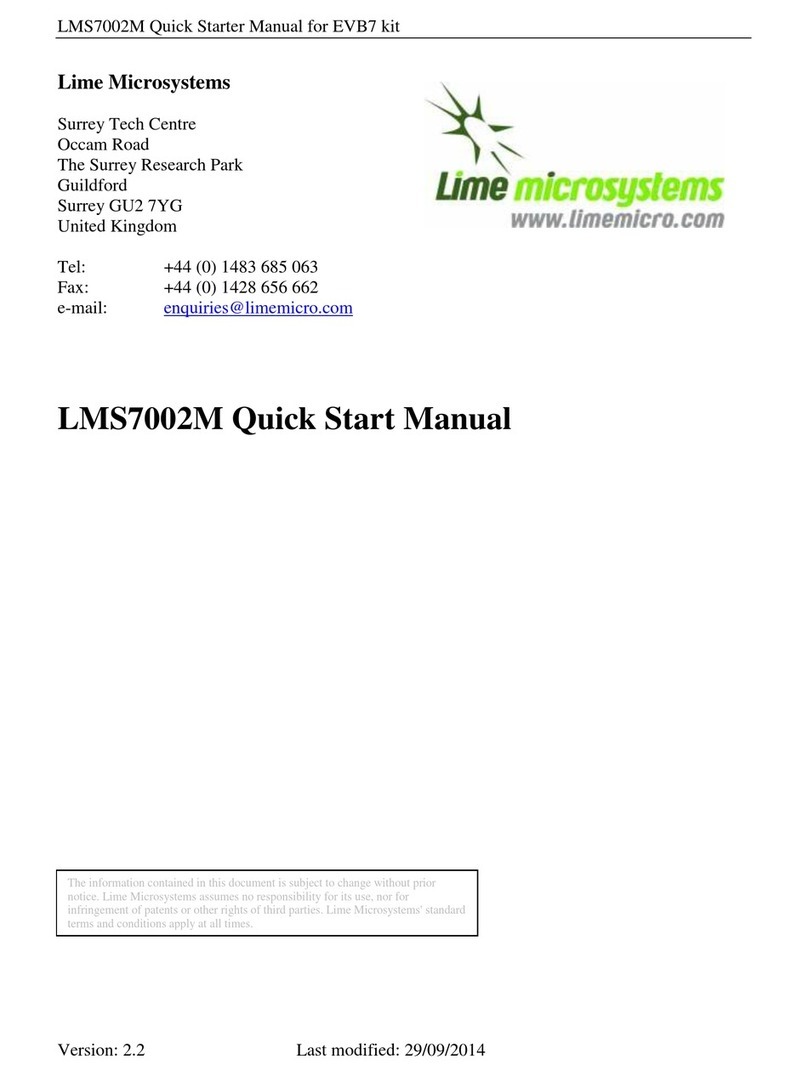Icom ic-80fx User manual

INSTRUCTION MANUAL
245 MHz FM TRANSCEIVER

i
FOREWORD
Thank you for purchasing this fine Icom product.
The
IC-80FX 245 MHZFM TRANSCEIVER is designed and build with
Icom’s superior technology and craftsmanship. With proper
care, this product should provide you with years of trouble-
free operation.
FEATURES
❍Dust-protection/Splash-resistant construc-
tion (IP54*)
*Only when the battery pack or case, antenna and jack cover are
attached.
❍Built in VOX circuit enabling VOX opera-
tion* (Voice Operated Transmission)
*To use the VOX function, an optional headset and a plug
adapter cable are required.
EXPLICIT DEFINITIONS
WORD DEFINITION
RDANGER! Personal death, serious injury or an ex-
plosion may occur.
RWARNING! Personal injury, fire hazard or electric
shock may occur.
CAUTION Equipment damage may occur.
NOTE Recommended for optimum use. No risk
of personal injury, fire or electric shock.
IMPORTANT
READ ALL INSTRUCTIONS carefully and completely
before using the transceiver.
SAVE THIS INSTRUCTION MANUAL— This in-
struction manual contains important operating instructions
for the IC-80FX.

ii
RDANGER! NEVER short the terminals of the battery
pack.
RWARNING RF EXPOSURE!
This device emits
Radio Frequency (RF) energy. Caution should be observed when
operating this device. If you have any questions regarding RF
exposure and safety standards, please refer to the Federal Com-
munications Commission Office of Engineering and Technology’s
report on Evaluating Compliance with FCC Guidelines for Human
Radio Frequency Electromagnetic Fields (OET Bulletin 65)
RWARNING! NEVER hold the transceiver so that
the antenna is very close to, or touching exposed parts of
the body, especially the face or eyes, while transmitting. The
transceiver will perform best if the microphone is 5 to 10 cm
away from the lips and the transceiver is vertical.
RWARNING! NEVER operate the transceiver with
a headset or other audio accessories at high volume levels.
Hearing experts advise against continuous high volume op-
eration. If you experience a ringing in your ears, reduce the
volume level or discontinue use.
RWARNING! NEVER operate the transceiver while
driving a vehicle. Safe driving requires your full attention—
anything less may result in an accident.
RWARNING! NEVER operate or touch the trans-
ceiver with wet hands. This may result in an electric shock or
may damage the transceiver.
DO NOT operate the transceiver near unshielded electri-
cal blasting caps or in an explosive atmosphere.
DO NOT push [PTT] unless you actually intend to transmit.
BE CAREFUL! The transceiver will become hot when
operating it continuously for long periods of time.
DO NOT use or place the transceiver in direct sun-
light or in areas with temperatures below –20°C or above
+60°C.
Place the unit in a secure place to avoid inadvertent use by
children.
DO NOT use harsh solvents such as benzine or alcohol
when cleaning, as they will damage the transceiver surfaces.
DO NOT disassemble or modify the transceiver for any
reason.
PRECAUTIONS

iii
Antenna
Battery pack*
Belt clip*
Jack cover
(with screws)
Battery charger*
AC adapter*
* Not supplied, or the shape is different, depending on the version.

iv
TABLE OF CONTENTS 1
2
3
4
5
6
7
8
9
10
11
12
13
14
15
16
17
18
19
FOREWORD ..................................................................................... i
FEATURES........................................................................................ i
EXPLICIT DEFINITIONS................................................................... i
IMPORTANT ...................................................................................... i
PRECAUTIONS............................................................................ii–iii
SUPPLIED ACCESSORIES............................................................ iii
TABLE OF CONTENTS................................................................... iv
1 ACCESSORIES ..........................................................1–2
■Accessory attachment ............................................................1
2 PANEL DESCRIPTION...............................................3–7
■Front, top and side panels.......................................................3
■Function display ......................................................................6
3 BATTERY CHARGING .............................................8–13
■Caution
(for the BP-264 Ni-MH battery)................................... 8
■Caution (for the BP-265 Li-Ion battery) ...................................9
■Battery chargers ...................................................................11
■
Battery case (BP-263) .............................................................. 13
■Battery information................................................................13
4 BASIC OPERATION ...............................................14–18
■Power ON/OFF .....................................................................14
■Adjusting the volume level ....................................................14
■Adjusting the squelch level....................................................14
■Monitor function ....................................................................14
■Setting an operating channel ................................................15
■Receiving ..............................................................................15
■Transmitting...........................................................................16
■Key lock function ................................................................... 16
■[VOL] function assignment ....................................................17
■Lockout function .................................................................... 17
■
Programming a channel name ................................................18
5 SCAN OPERATION ................................................19–20
■Scan types ............................................................................19
■Channel scan........................................................................19
■Setting skip channels............................................................19
■ Scan resume setting .............................................................20
■Priority watch ........................................................................20
6 TONE SQUELCH AND POCKET BEEP ................21–24
■
Tone/DTCS squelch and pocket beep...................................21
■Tone scan..............................................................................23
■Subaudible tone encoder......................................................24
7 DTMF MEMORY .....................................................25–27
■
Programming a DTMF code sequence .................................25
■
Transmitting a DTMF code sequence....................................26
■Confirming a DTMF memory ................................................27
■Setting DTMF transfer speed ................................................27
8 SET MODES ...........................................................28–36
■Set mode programming ........................................................ 28
■Set mode items.....................................................................29
■
Initial Set mode programming.................................................. 32
■Initial Set mode items............................................................33
9 CLONING......................................................................37
■Cloning operation..................................................................37
10 TROUBLE SHOOTING .................................................38
11 OPTIONS ................................................................39–41
■VOX function .........................................................................40
12 SPECIFICATIONS ........................................................42

11
■Accessory attachment
DAntenna
Insert the antenna into the antenna connector and twist the
antenna base to lock it in place.
CAUTION:
• NEVER HOLD just the antenna when carrying the trans-
ceiver.
• Transmitting without an antenna will damage the trans-
ceiver.
DBelt clip
To attach the belt clip:
Slide the belt clip in the direction of the arrow until the belt
clip locks in place, and makes a ‘click’ sound.
To detach the belt clip:
qRemove the battery pack or case from the transceiver, if it
is attached. (p. 2)
wLift the tab up (q), and slide the belt clip in the direction
of the arrow (w).
ACCESSORIES
1
Belt clip
Battery pack/case
q
w

2
1
DBattery pack or case
To attach the battery pack or case:
q
Fit the battery pack or case in the direction of the arrow,
then close it.
wHook the latch until it makes a ‘click’ sound.
To remove the battery pack or case:
Be careful! The latch is tightly locked, so use caution
when releasing it. DO NOT use your fingernail. Use the
edge of a coin or screwdriver tip to carefully release it.
qUnhook the latch.
w
Lift up the battery pack or case in the direction of the arrow.
NEVER remove or attach the battery pack or case when
the transceiver is wet or soiled. This may result in water
or dust getting into the transceiver or the battery pack/
case, and may result in them being damaged.
NOTE: Keep the battery terminals clean.
DJack cover
Attach the jack cover when optional equipment is not used.
1
ACCESSORIES
2
3
4
5
6
7
8
9
10
11
12
13
14
15
16
17
18
19
To attach the jack cover
qAttach the jack cover to
the [SP MIC] jack.
wTighten the screws.
To detach the jack cover
qRemove the screws with
a phillips screwdriver.
wDetach the jack cover to
connect optional equip-
ment.
w
q
Latch
Battery pack/case
q
w
w
w
qw
q
q

3
PANEL DESCRIPTION
2
■Front, top and side panels
qPTT SWITCH [PTT]
Hold down to transmit, release to receive. (p. 16)
wANTENNA CONNECTOR
Connect an antenna here. (p. 1)
eCONTROL DIAL [VOL]
➥Adjust the volume level. (p. 14)
➥While in the Set mode, or Initial Set mode, rotate to se-
lect a desired option or value. (pp. 28, 32)
rEXTERNAL SPEAKER/MICROPHONE JACKS [SP MIC]
Accepts an optional speaker-microphone, plug adapter
cable or cloning cable connector. The internal microphone
and speaker will not function when an option is con-
nected. See page 39 for a list of available options.
Be sure to turn OFF the transceiver power before con-
necting or disconnecting optional equipment to or from
the [SP/MIC] jack.
tMONITOR KEY [MONI]
➥Hold down to temporarily open the squelch to monitor
the operating channel. (p. 14)
➥While holding down this key, push [S]or [T]to adjust
the squelch level. (p. 14)
➥Enters or sends the DTMF code ‘A.’ (p. 26)
yPOWER KEY [ ]
Hold down for 1 second to turn the transceiver power ON
or OFF. (p. 14)
q
we
r
t
y
u
i
Function
display (p. 6)
Keypad (pp. 4, 5)
Microphone
Speaker

4
2
uUP/DOWN KEYS [S]/[T]
➥Push to change the operating channel. (p. 15)
➥In the DTMF memory mode, push to select a DTMF
memory channel. (p. 25)
➥While scanning, push to change the scanning direction.
(pp. 19, 23)
➥While holding down [MONI], push to adjust the squelch
level. (p. 14)
➥While in the Set mode, or Initial Set mode, push to se-
lect a setting item. (pp. 28, 32)
➥[S] enters or sends the DTMF code ‘B.’ (p. 26)
➥[T] enters or sends the DTMF code ‘C.’ (p. 26)
iLOCK KEY [ ]
After pushing [FUNC](M), hold down for 1 second
to turn
the Key Lock function ON or OFF. (p. 16)
The functions of [VOL] and [S]/[T]can be exchanged.
See page 17 for details.
DKEYPAD
➥Push to
enter a operating
enter a operating
channel number. (p. 15)
channel number. (p. 15)
➥Push to enter or send the DTMF code. (p. 26)
➥Pushing these keys, after pushing [FUNC](M), activates
the key’s second function.
[1] • [ TONE](1)
➥Numeric i
nput and DTMF code: ‘1’
nput and DTMF code: ‘1’
➥After pushing [FUNC](M), selects the Tone func-
tion. (p. 22)
[2] • [VOX](2)
➥Numeric i
nput and DTMF code: ‘2’
nput and DTMF code: ‘2’
➥After pushing [FUNC](M), turns the VOX function
ON or OFF*. (p. 40)
* Only when an optional headset and plug adapter are
connected.
2
PANEL DESCRIPTION
1
3
4
5
6
7
8
9
10
11
12
13
14
15
16
17
18
19

5
[3] • [T.SCAN](3)
➥Numeric i
nput and DTMF code: ‘3’
nput and DTMF code: ‘3’
➥After pushing [FUNC](M), starts a tone scan.
(p. 23)
[4]
Numeric i
nput and DTMF code: ‘4’
nput and DTMF code: ‘4’
[5] • [SCAN](5)
➥Numeric i
nput and DTMF code: ‘5’
nput and DTMF code: ‘5’
➥After pushing [FUNC](M), starts a scan. (p. 19)
[6] • [SKIP](6)
➥Numeric i
nput and DTMF code: ‘6’
nput and DTMF code: ‘6’
➥After pushing [FUNC](M), sets or cancels the
skip setting. (p. 19)
[7] • [PRIO](7)
➥Numeric i
nput and DTMF code: ‘7’
nput and DTMF code: ‘7’
➥After pushing [FUNC](M), starts a priority watch.
(p. 29)
[8] • [SET](8)
➥Numeric i
nput and DTMF code: ‘8’
nput and DTMF code: ‘8’
➥After pushing [FUNC](M), enters the Set mode.
(p. 28)
[9] • [H/M/L](9)
➥Numeric i
nput and DTMF code: ‘9’
nput and DTMF code: ‘9’
➥After pushing [FUNC](M), selects the output
power between high, mid and low. (p. 16)
[0] • [DTMF-M](0)
➥Numeric i
nput and DTMF code: ‘0’
nput and DTMF code: ‘0’
➥After pushing [FUNC](M), enters the DTMF
memory mode. (p. 25)
[M] • [FUNC](M)
➥
DTMF code: ‘
DTMF code: ‘M(indication: E)
’
’
➥Push to access the second function of other keys.
[# ENT] • [MN.W](# ENT)
➥
DTMF code: ‘
DTMF code: ‘#(indication: F)
’
’
➥After entering a channel number (0-9), push to
set the channel. (p. 15)
➥Push to exit the Set mode or Initial Set mode.
(pp. 28, 32)
2PANEL DESCRIPTION
■Front, top and side panels
DKEYPAD (Continued)

6
2
■Function display
qBUSY ICON
➥Appears when a signal is being received, or the
squelch is open.
➥Blinks while the Monitor function is ON. (p. 14)
wSIGNAL ICONS
➥Shows the strength of the received signal. (p. 15)
➥While transmitting, shows the output power level.
(p. 16)
eTONE ICONS
➥“ ” appears while the Subaudible tone encoder is ON.
(p. 24)
➥“ ” appears while the Tone Squelch function is ON.
(p. 21)
➥“
D” appears while the DTCS Squelch function is ON.
(p. 21)
➥“ ” appears with the “ ” or “
D
” icon while the Pocket
Beep function (with CTCSS or DTCS) is ON. (p. 21)
rMEMORY ICON
Blinks while scanning. (p. 19)
tALPHANUMERIC DISPLAY
➥Displays the operating channel, channnel name, Set
modes’ contents and a variety of other information.
• The decimal point blinks during a scan.
➥Displays the selected DTMF memory channel number.
(p. 25)
yBATTERY ICONS (p. 13)
➥“” appears when the battery pack/case is attached.
➥“” appears when the battery is nearing exhaustion.
Charging the battery pack, or replacing the batteries in
the case is necessary.
2
PANEL DESCRIPTION
Weak RX Signal level Strong
Low Mid High
u
i
o
qw e r y
t
(Decimal Point)
!3
!2
!1
!0
1
3
4
5
6
7
8
9
10
11
12
13
14
15
16
17
18
19

7
■Function display (Continued)
uKEY LOCK ICON
Appears when the Key Lock function is ON. (p. 16)
iVOX ICON
Appears when the VOX function is ON. (p. 40)
oPOWER ICONS (p. 16)
➥“H” appears when high power is selected.
➥“M” appears when mid power is selected.
➥“L” appears when low power is selected.
!0AUTO POWER OFF ICON
Appears when the Auto Power OFF function is ON. (p. 33)
!1SKIP ICON
Appears when the selected memory channel is set as a
skip channel. (p. 19)
!2FUNCTION ICON
Appears when the second function can be accessed.
!3TRANSMIT ICON
Appears while transmitting. (p. 16)
2PANEL DESCRIPTION

8
2
3
3
BATTERY CHARGING
■Caution
(for the BP-264 Ni-MH battery)
RDANGER! NEVER short terminals (or charging terminals)
of the battery pack. Also, current may flow into nearby metal
objects such as a necklace, so be careful when placing bat-
tery packs (or the transceiver) in handbags, etc.
Simply carrying with or placing near metal objects such as
a necklace, etc. may cause shorting. This may damage not
only the battery pack, but also the transceiver.
RDANGER! NEVER incinerate used battery packs. Internal
battery gas may cause an explosion.
RDANGER! NEVER immerse the battery pack in water.
If the battery pack becomes wet, be sure to wipe it dry BE-
FORE attaching it to the transceiver.
CAUTION: Always use the battery within the specified tem-
perature range, –5˚C to +60˚C. Using the battery out of its
specified temperature range will reduce the battery’s perfor-
mance and battery life.
CAUTION: Shorter battery life could occur if the battery is
left completely discharged, or in an excessive temperature
environment (above +55˚C) for an extended period of time.
If the battery must be left unused for a long time, it must be
detached from the radio after charging. Keep it safely in a
cool dry place at the following temperature range:
–20˚C to +45˚C (up to a month)
–20˚C to +35˚C (up to six months)
–20˚C to +25˚C (up to a year*)
* We recommend charging the battery pack every 6 months.
Clean the battery terminals to avoid rust or misscontact.
Keep battery terminals clean. It’s a good idea to clean bat-
tery terminals once a week.
If your Ni-MH battery pack seems to have no capacity, even
after being charged, completely discharge it by leaving the
power ON overnight. Then, fully charge the battery pack again.
If the battery pack still does not retain a charge (or only very lit-
tle charge), a new battery pack must be purchased. (p. 39)
Prior to using the transceiver for the first time, the battery
pack must be fully charged for optimum life and operation.
• Recommended temperature range for charging:
between +10°C and +40°C (rapid charge: with BC-191) or
between 0°C and +45°C (regular charge: with BC-192)
• Use the supplied charger or optional charger (BC-191 for
rapid charging, BC-192 for regular charging) only. NEVER
use other manufacturers’ chargers.
The battery pack contains a rechargeable battery.
Charge the battery pack before first operating the trans-
ceiver, or when the battery pack becomes exhausted.
If you want to prolong the battery life, the following points
should be observed:
• Avoid over charging. The charging time period should be
less than 48 hours.
• Use the battery pack until it becomes almost completely
exhausted, under normal conditions. We recommend bat-
tery charging after transmitting becomes impossible.
1
4
5
6
7
8
9
10
11
12
13
14
15
16
17
18
19

9
■Caution (for the BP-265 Li-Ion battery)
RDANGER! NEVER short terminals (or charging terminals)
of the battery pack. Also, current may flow into nearby metal
objects such as a necklace, so be careful when placing bat-
tery packs (or the transceiver) in handbags, etc.
Simply carrying with or placing near metal objects such as
a necklace, etc. may cause shorting. This may damage not
only the battery pack, but also the transceiver.
RDANGER! Use and charge only specified Icom battery
packs with Icom radios or Icom chargers. Only Icom battery
packs are tested and approved for use with Icom radios or
charged with Icom chargers. Using third-party or counterfeit
battery packs or chargers may cause smoke, fire, or cause
the battery to burst.
DBattery caution
RDANGER! DO NOT hammer or otherwise impact the bat-
tery. Do not use the battery if it has been severely impacted
or dropped, or if the battery has been subjected to heavy
pressure. Battery damage may not be visible on the outside
of the case. Even if the surface of the battery does not show
cracks or any other damage, the cells inside the battery may
rupture or catch fire.
RDANGER! NEVER use or leave battery pack in areas
with temperatures above +60˚C. High temperature buildup in
the battery, such as could occur near fires or stoves, inside a
sun heated car, or in direct sunlight may cause the battery to
rupture or catch fire. Excessive temperatures may also de-
grade battery performance or shorten battery life.
RDANGER! DO NOT expose the battery to rain, snow, sea-
water, or any other liquids. Do not charge or use a wet battery.
If the battery gets wet, be sure to wipe it dry before using.
RDANGER! NEVER incinerate a used battery pack since
internal battery gas may cause it to rupture, or may cause
an explosion.
RDANGER! NEVER solder the battery terminals, or
NEVER modify the battery pack. This may cause heat gener-
ation, and the battery may burst, emit smoke or catch fire.
RDANGER! Use the battery only with the transceiver for
which it is specified. Never use a battery with any other
equipment, or for any purpose that is not specified in this in-
struction manual.
RDANGER! If fluid from inside the battery gets in your
eyes, blindness can result. Rinse your eyes with clean water,
without rubbing them, and see a doctor immediately.
RWARNING! Immediately stop using the battery if it emits an
abnormal odor, heats up, or is discolored or deformed. If any of
these conditions occur, contact your Icom dealer or distributor.
R
WARNING! Immediately wash, using clean water, any
part of the body that comes into contact with fluid from in-
side the battery.
3BATTERY CHARGING
Misuse of Li-Ion batteries may result in the following haz-
ards: smoke, fire, or the battery may rupture. Misuse can
also cause damage to the battery or degradation of battery
performance.

10
3
3
BATTERY CHARGING
R
WARNING! NEVER put the battery in a microwave oven,
high-pressure container, or in an induction heating cooker.
This could cause a fire, overheating, or cause the battery to
rupture.
CAUTION: Always use the battery within the specified tem-
perature range, –20˚C to +60˚C. Using the battery out of its
specified temperature range will reduce the battery’s perfor-
mance and battery life.
CAUTION: Shorter battery life could occur if the battery is
left fully charged, completely discharged, or in an excessive
temperature environment (above +50˚C) for an extended pe-
riod of time. If the battery must be left unused for a long time,
it must be detached from the radio after discharging. You
may use the battery until the battery indicator shows half-ca-
pacity, and then keep it safely in a cool dry place at the fol-
lowing temperature range:
–20˚C to +50˚C (up to a month)
–20˚C to +35˚C (up to three months)
–20˚C to +20˚C (up to a year)
DCharging caution
RDANGER! NEVER charge the battery pack in areas with
extremely high temperatures, such as near fires or stoves,
inside a sun-heated vehicle, or in direct sunlight. In such en-
vironments, the safety/protection circuit in the battery will ac-
tivate, causing the battery to stop charging.
R
WARNING! DO NOT charge or leave the battery in the
battery charger beyond the specified time for charging. If the
battery is not completely charged by the specified time, stop
charging and remove the battery from the battery charger.
Continuing to charge the battery beyond the specified time
limit may cause a fire, overheating, or the battery may rup-
ture.
R
WARNING! NEVER insert the transceiver (battery at-
tached to the transceiver) into the charger if it is wet or
soiled. This could corrode the battery charger terminals or
damage the charger. The charger is not waterproof.
CAUTION: DO NOT charge the battery outside of the speci-
fied temperature range: BC-193 (+10˚C to +40˚C
). Icom rec-
ommends charging the battery at +20˚C. The battery may
heat up or rupture if charged out of the specified tempera-
ture range. Additionally, battery performance or battery life
may be reduced.
The supplied battery pack, charger, and AC adapter dif-
fer, or no supplied depending on the version.
Prior to using the transceiver for the first time, the battery
pack must be fully charged for optimum life and operation.
1
2
4
5
6
7
8
9
10
11
12
13
14
15
16
17
18
19

11
■Battery chargers
D
Using the BC-191 to rapid charge the BP-264
The BC-191 provides rapid charging of only the BP-264 Ni-MH
battery pack. Never use it to charge any other battery pack.
Charging time: Approximately 2 hours
The following item is additionally required:
• An AC adapter (not supplied with some versions) or the OPC-515L
or CP-23L DC power cable.
DUsing the BC-192 to regular charge the BP-264
The BC-192 provides regular charging of only the BP-264
Ni-MH battery pack. Never use it to charge any other battery
pack.
Charging time (with the 147S): Approximately 16 hours
The following item is additionally required:
• An AC adapter (not supplied with some versions) or the OPC-515L
DC power cable.
3BATTERY CHARGING
The optional OPC-515L
(for DC power source)
can be used instead of
the AC adapter.
Charge indicator
• Lights green while charging.
NOTE:
The charge indicator will not
go out even after a battery
pack is fully charged.
AC adapter
(A different type, or no AC
adapter is supplied, de-
pending on the version.)
Transceiver
Battery pack
Screws*
(Self tapping screw:
3.5 × at least 30 mm)
*Purchase separately.
Using screws is
recommended to
secure the charger.
Charging time period differs
depending on the input voltage.
12 V : Approx. 36 hours
13.8 V : Approx. 21 hours
16 V : Approx. 16 hours
Turn OFF the power
The optional OPC-515L (for DC
power source) or CP-23L (for 12 V
cigarette lighter socket) can be
used instead of the AC adapter.
Charge indicator
• Lights orange : While charging
• Lights green :
Charging is completed.
AC adapter
(A different type, or no AC
adapter is supplied, de-
pending on the version.)
Transceiver
Turn OFF the power
Battery pack
Screws*
(Self tapping screw:
3.5 × at least 30 mm)
*Purchase separately.
Using screws is
recommended to
secure the charger.

12
3
3
BATTERY CHARGING
D
Using the BC-193 to rapid charge the BP-265
The BC-193 provides rapid charging of only the BP-265 Li-
Ion battery pack. Never use it to charge any other battery
pack.
Charging time: Approximately 2.5 hours
The following item is additionally required:
• An AC adapter (not supplied with some versions) or the OPC-515L
or CP-23L DC power cable.
IMPORTANT: Battery charging caution
Ensure the tabs on the battery pack are correctly aligned
with the guide rails inside the charger.
CAUTION: When using the OPC-515L DC power cable
NEVER connect the OPC-515L to a power source using
reverse polarity. This will ruin the battery charger.
White line: +Black line: –
The optional OPC-515L
(for DC power source) or
CP-23L (for 12 V cigarette
lighter socket) can be used
instead of the AC adapter.
AC adapter
(A different type, or no AC
adapter is supplied, de-
pending on the version.)
Transceiver
Turn OFF the power
Battery pack
Screws*
(Self tapping screw:
3.5 × at least 30 mm)
*Purchase separately.
Using screws is
recommended to
secure the charger.
Charge indicator
• Lights orange : While charging
• Lights green :
Charging is completed.
Guide rail
Tabs
1
2
4
5
6
7
8
9
10
11
12
13
14
15
16
17
18
19

13
■Battery case (BP-263)
When using the battery case (BP-263), install 6 ×AA (LR6)
size alkaline batteries, as described below.
qRemove the battery case if it is attached. (p. 2)
wInstall 6 × AA (LR6) size alkaline batteries.
• Install only alkaline batteries.
• Be sure to observe the correct polarity.
eAttach the battery case. (p. 2)
CAUTION:
• When installing batteries, make sure they are all the
same brand, type and capacity. Also, do not mix new
and old batteries together.
• Keep battery terminals clean. It’s a good idea to clean
battery terminals once a week.
• Never incinerate used battery cells, since the internal
battery gas may cause them to rupture.
•
Never expose a detached battery case to water. If the bat-
tery case gets wet, be sure to wipe it dry before using it.
•
Never use batteries whose insulated covering is damaged.
NOTE:
When the battery case is attached, the Battery Pro-
tection function must be turned OFF in the Initial Set mode
(p. 36).
■Battery information
DBattery life
Even when the transceiver power is OFF, a small current
still flows in the transceiver.
Remove the battery pack/case
when it won’t be used for a long time.
Otherwise, the battery
pack or the batteries in the case will become exhausted.
DBattery icon
3BATTERY CHARGING
Battery pack/case
Voltage Capacity Battery life*1
BP-263 Battery case for
AA (LR6) × 6 alkaline —*2
BP-264 7.2 V 1400 mAh 13 hrs.
(approx.)
BP-265 7.4 V 1900 mAh (min.)
2000 mAh (typ.)
18.5 hrs.
(approx.)
*1
When the Power Save function is set to “P–S.At” (p. 35) and the
operating time is calculated under the following conditions;
TX : RX : standby = 5 : 5 : 90
*2The average operating life depends on the alkaline cells used.
Icon Battery condition
The battery has ample capacity.
The battery is nearing exhaustion.
Charging the battery pack, or replacing the batteries
in the case is necessary.
Be careful! The negative termi-
nals of the battery case protrude
from the body, so pay attention
not to injure your fingers when
inserting the batteries.

14
3
4
■Power ON/OFF
➥
Hold down [ ] for 1 second to turn the power ON or OFF.
The voltage indication can be turned OFF in the Initial Set
mode (p. 36).
■Adjusting the volume level
➥Rotate [VOL] to
adjust the volume level.
• If the squelch is closed, hold down [MONI] while adjusting the
volume level.
• The display shows the volume level while adjusting.
■Adjusting the squelch level
➥While holding down [MONI], push [S]or [T]several
times
to adjust the squelch level.
• “SqL 1” is loose squelch (for weak signals) and “SqL10” is tight
squelch (for strong signals). “SqL 0” is open squelch.
■Monitor function
This function is used to listen to weak signals, or to open
the squelch manually. You can use it without disturbing the
squelch setting, even when mute functions such as the tone
squelch are in use.
➥Hold down [MONI] to monitor the operating channel.
• “ ” blinks while the Monitor function is ON.
4
BASIC OPERATION
1
2
5
6
7
8
9
10
11
12
13
14
15
16
17
18
19

15
■
Selecting an operating channel
DChannel selection using [S]or [T]
➥ Push [S]or [T]to select the channel.
• Holding down [S]or [T]makes selecting a channel quick.
DChannel entry using the keypad
➥To select a channel between 10 and 80, simply enter
the channel number.
➥To select a channel between 1 and 9, first enter a “0”
and then enter the channel number.
• Entering the channel number and pushing [# ENT](MN.W)
also selects the channel.
• Example 1— entering channel 12
Push
• Example 2— entering channel 8
Push
■Receiving
Make sure the BP-264 or BP-265 battery pack is fully
charged, or the BP-263 battery case has brand new alkaline
batteries (pp. 11–13).
qHold down []for 1 second to turn ON the power.
wSet the operating channel.
• Refer to the left column to select a channel.
eRotate [VOL] to set the volume level. (p. 14)
• If the squelch is closed, hold down [MONI] while adjusting the
volume level.
rAdjust the squelch level. (p. 14)
• While holding down [MONI], push [S]or [T].
• The squelch level is displayed on the LCD while setting.
• “SqL 1” is loose squelch (for weak signals) and “SqL10” is tight
squelch (for strong signals). “SqL 0” is open squelch.
tWhen a signal is received:
• The squelch opens and audio is heard.
• The signal indicator shows the relative signal strength level.
4BASIC OPERATION
eAdjust the volume level.
r
For the squelch level setting.
qTurn ON the power.
wSet the receive channel.
rAdjust the squelch level.
Table of contents
Other Icom Transceiver manuals
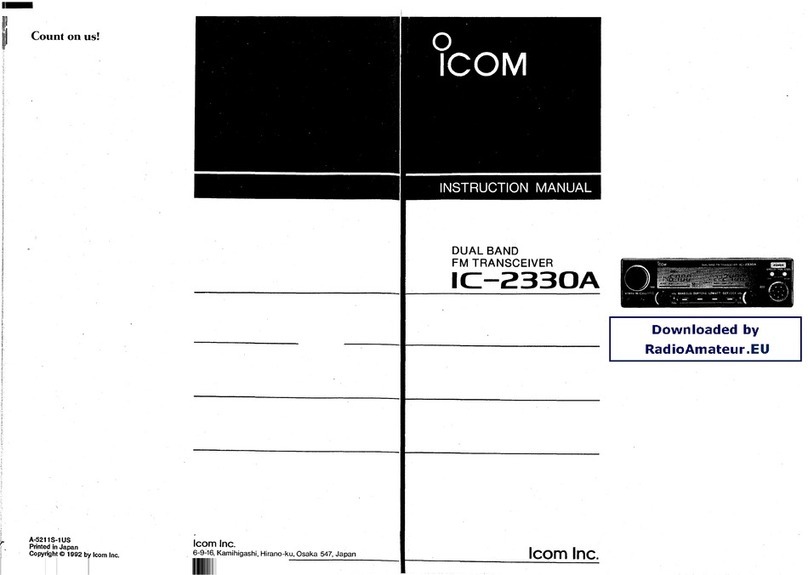
Icom
Icom IC-2330A User manual
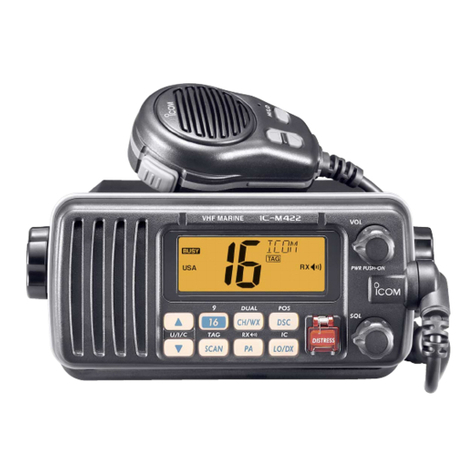
Icom
Icom IC-M422 User manual

Icom
Icom IC-F1710 User manual
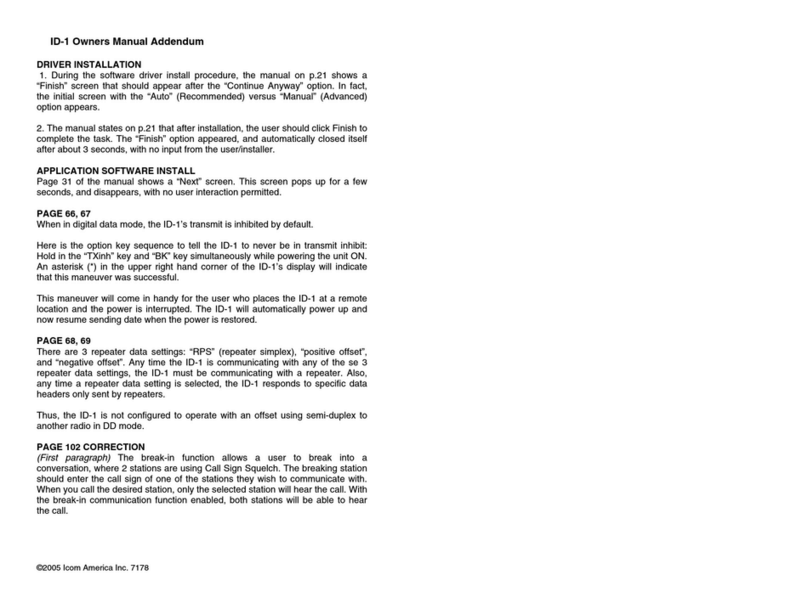
Icom
Icom ID-1 Installation and operating instructions
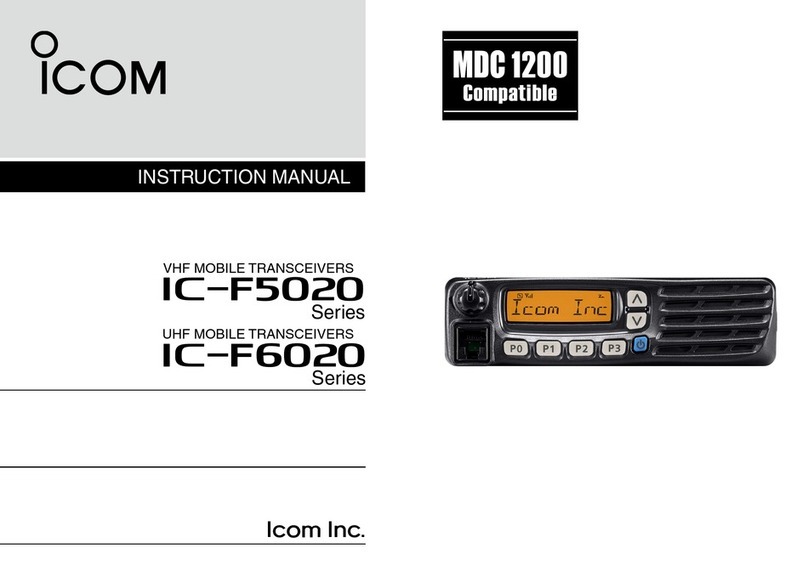
Icom
Icom IC-F5020 Series User manual
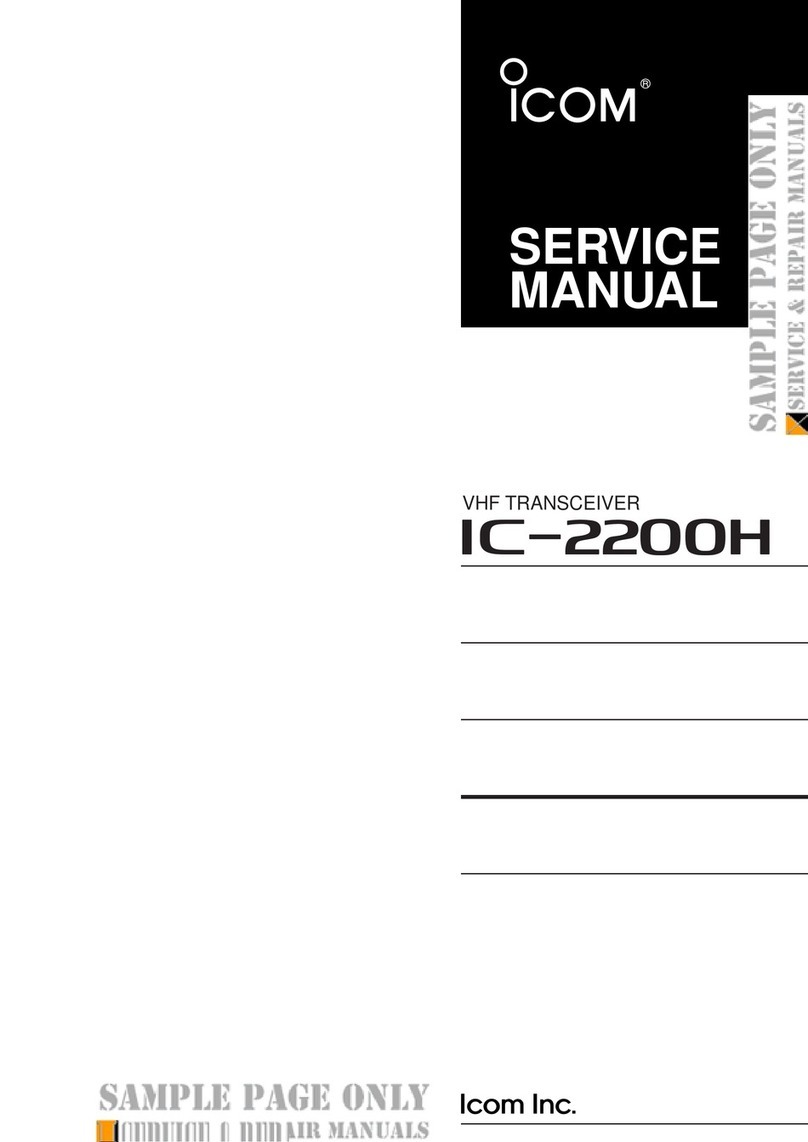
Icom
Icom IC-2200H User manual

Icom
Icom IC-7100 Setup guide
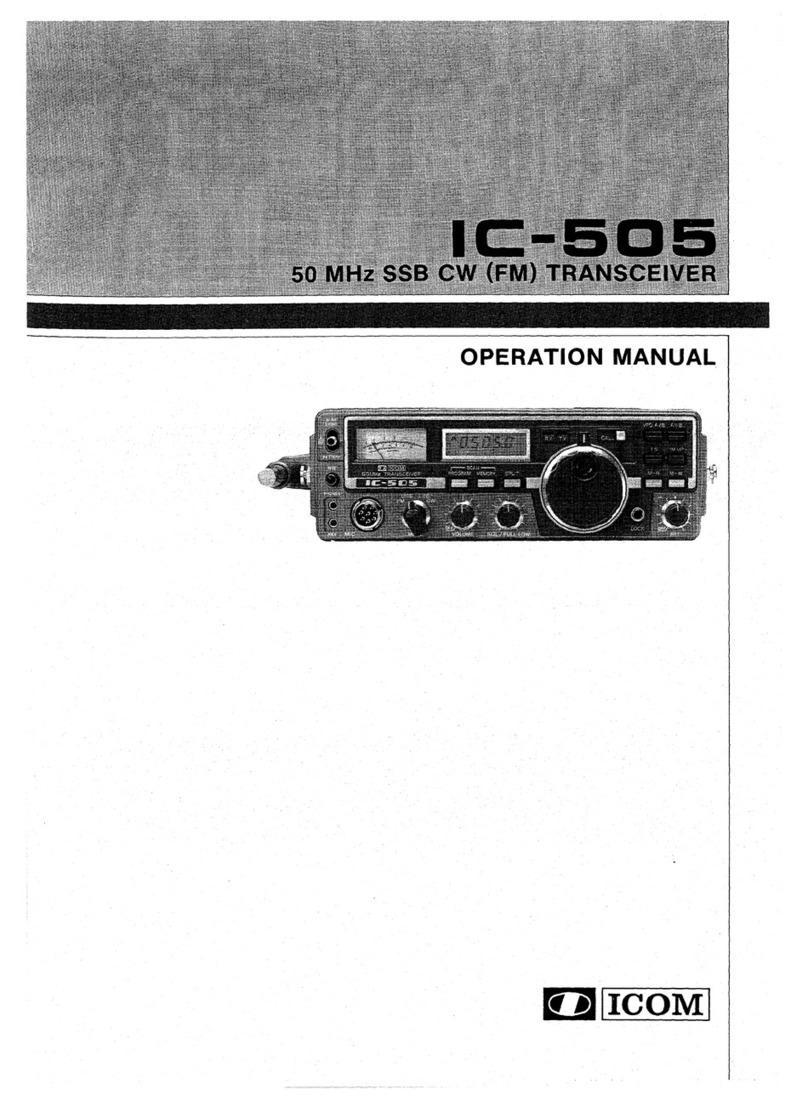
Icom
Icom IC-505 User manual

Icom
Icom IC-2710H User manual

Icom
Icom IC-718 User manual
Popular Transceiver manuals by other brands
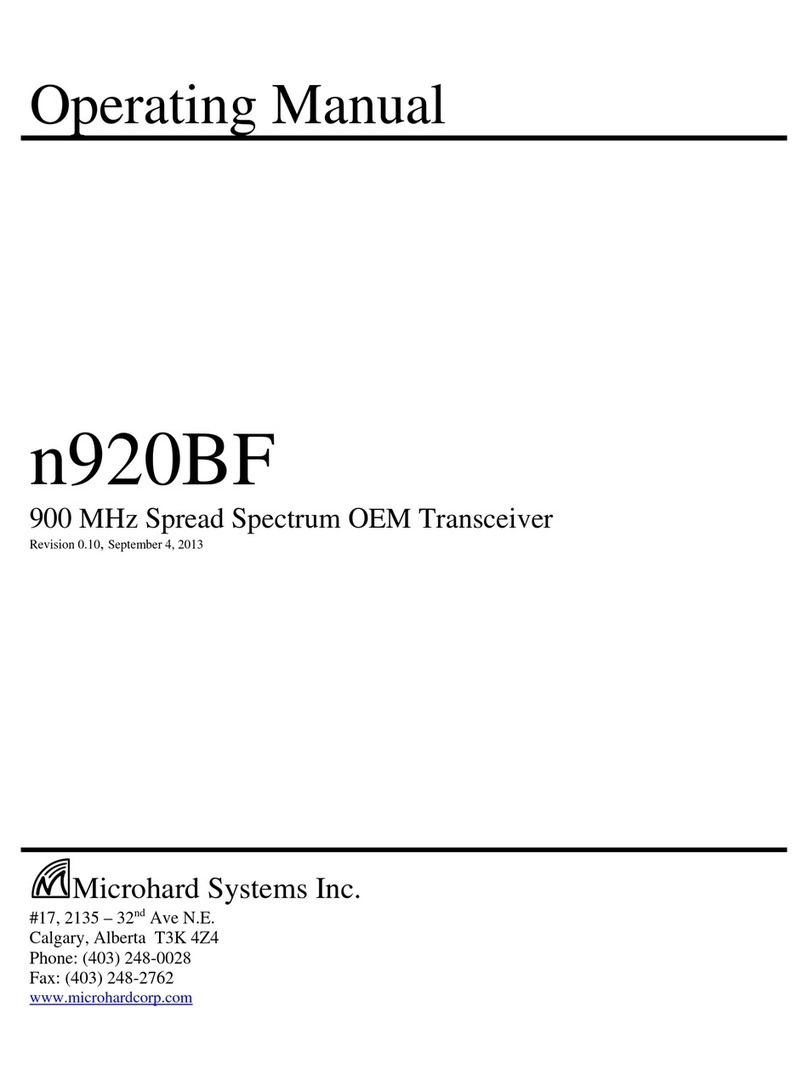
Microhard Systems
Microhard Systems n920BF operating manual

Kenwood
Kenwood TS-430S instruction manual
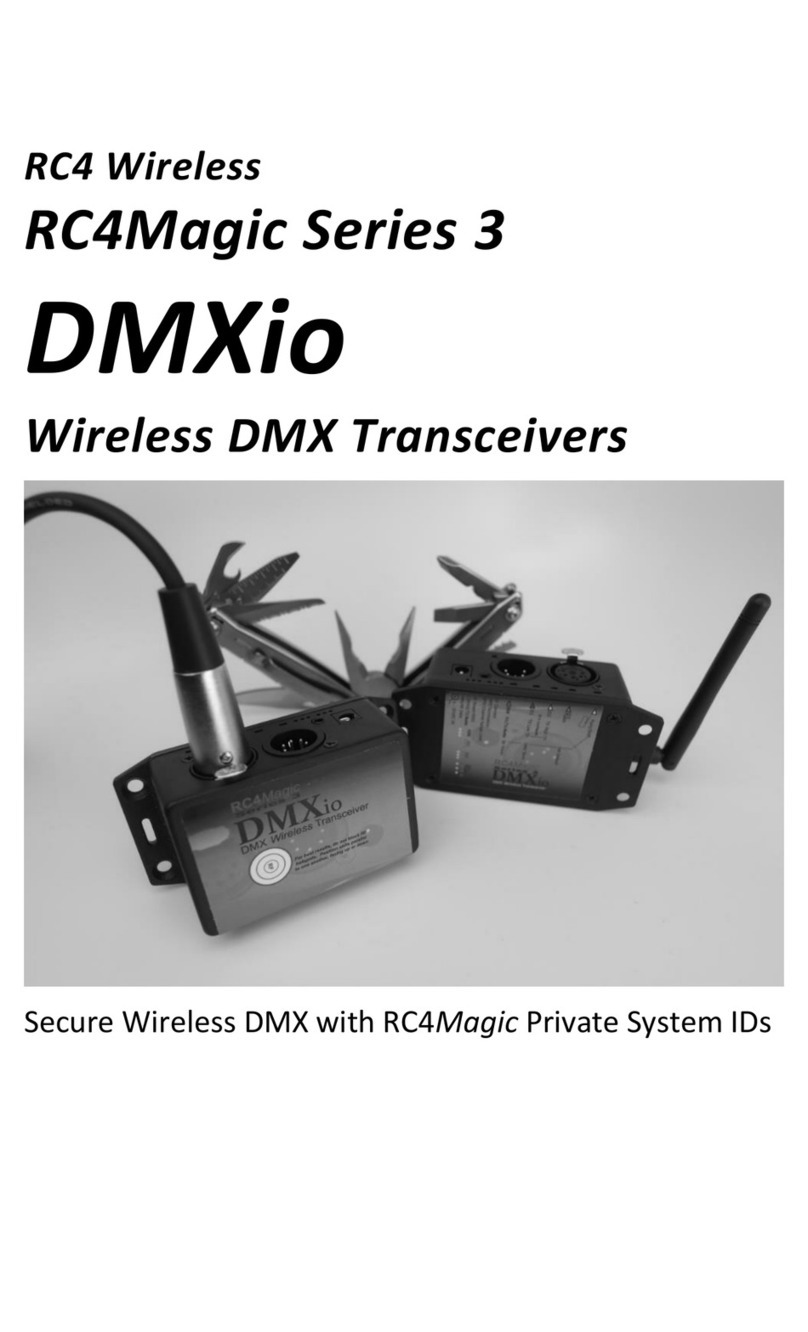
RC4
RC4 RC4Magic Series 3 DMXio user manual
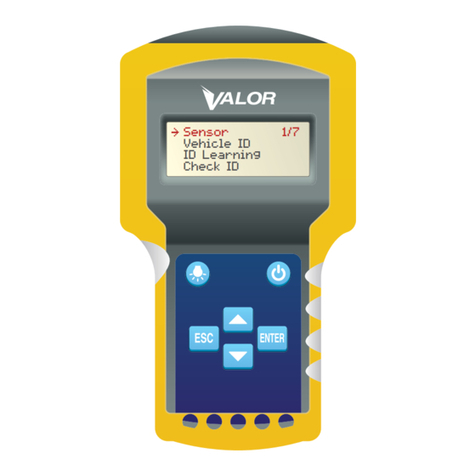
Valor
Valor EXTREME DUTY TPMS Programming guide

Vertex Standard
Vertex Standard VX-420 Series Service manual
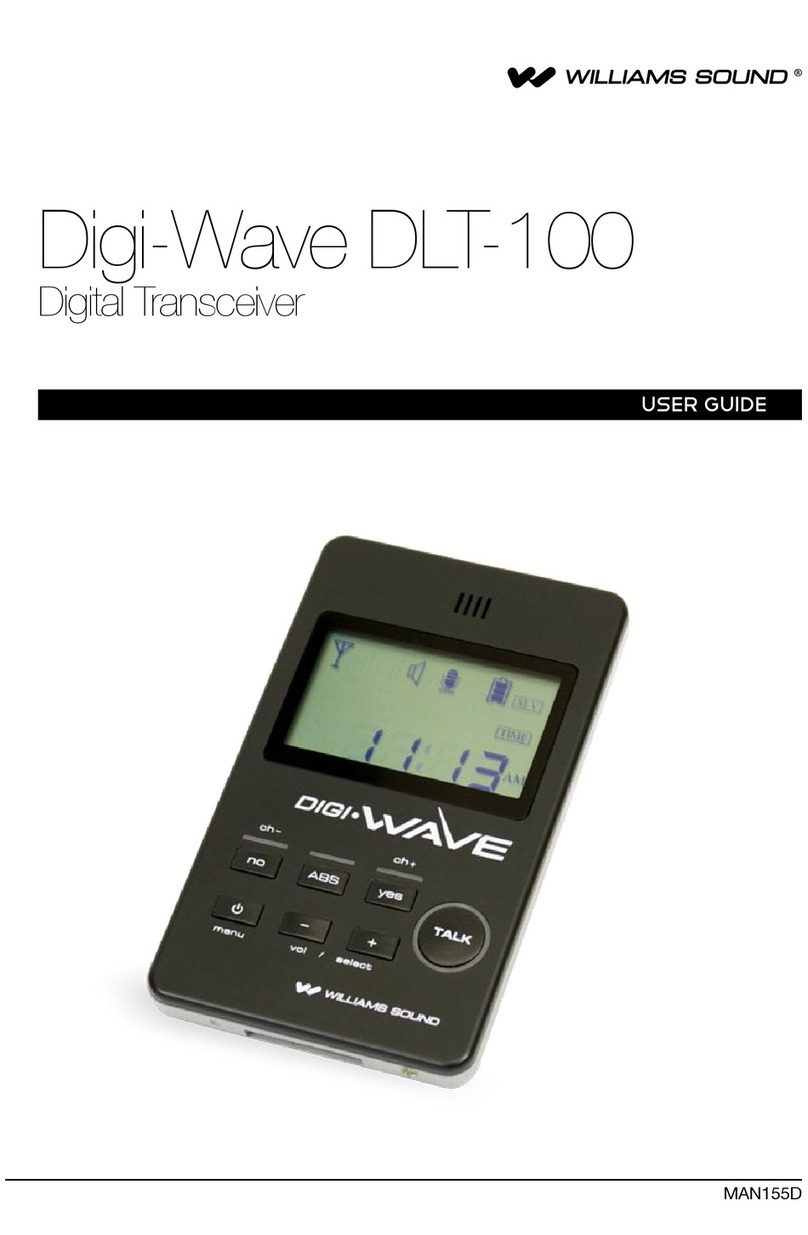
Williams Sound
Williams Sound Digi-Wave DLT-100 user guide
